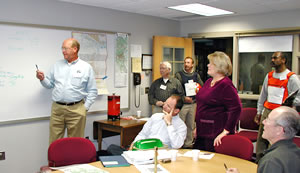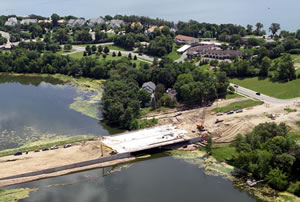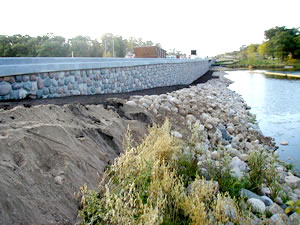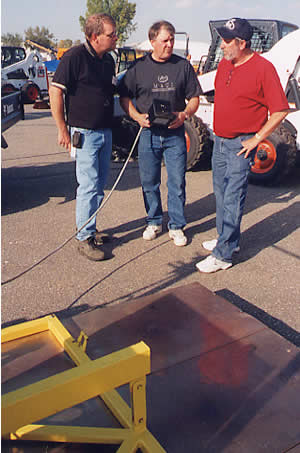 |
 |
|
 |
Mock disasters test staff in homeland security exercise
|
 |
 |
 |
|
More than 150 Mn/DOT employees participated in the two-day homeland security training drill at Camp Ripley on Oct. 12-13. Standing from left are Bob Winter, Doug Differt, Larry Thompson, Carol Molnau and Ernest Lloyd. Seated are Bob McFarlin and Dick Stehr. Photo by John Bray
|
On Oct. 12-13, Mn/DOT's world rocked—at least theoretically.
As part of a two-day homeland security drill at Camp Ripley near Little Falls, more than 150 employees from Mn/DOT, the Department of Public Safety and the National Guard faced various fictional crises that could befall state bridges and roadways and enacted Mn/DOT’s potential responses to them.
Not an easy task when you consider that the participants had to contend with hypothetical situations that included bridge and pipeline explosions, overturned tankers and a record-setting snowstorm—all happening simultaneously.
"Our state has a large trunk highway system with many bridges," said Lt. Gov. Carol Molnau, commissioner of transportation and one of the drill participants.
"And those roads connect many large centers of commerce and other destinations that people have to get to. It is important that we know what we will do in emergency situations so that we can more quickly get things to return to normal."
Sonia Pitt, Mn/DOT's homeland security director, said the goals of the drill were to identify strengths and weaknesses in the department’s emergency response function.
"Mn/DOT has always taken part in larger drills conducted by the state," she said. "This gave us the chance to pull our own team together, with some outside help, and test things on more of a district level."
Short, Elliot and Hendrickson, engineering consultants, were hired to assist in developing the scenarios and running the exercise. There were two groups of people: those being evaluated and those observing and controlling the exercise.
"District 19" was established and headed by Lynn Eaton, Bemidji/District 2 transportation engineer. He had management staff as well as some maintenance workers and equipment.
Mn/DOT also set up an emergency operations center in a building separate from District 19. Representatives from the Department of Public Safety’s Division of Homeland Security and Emergency Management and the National Guard, as they would in a real crisis, also staffed the emergency operations center.
The exercise controllers would call either the district or the EOC with scenario developments describing various problems or asking for bits of information.
Mn/DOT’s senior staff was on hand for the first day, taking in information and pushing out decisions. The work was hampered by limited phone capability and no computer access.
Also part of the exercise was the fictional Transportation News Network or TNN. It ran a steady broadcast of international, national and local news throughout the day. Role-playing reporters from TNN interviewed exercise participants and produced news stories that regularly ran on the station. The EOC public affairs representatives provided media briefings throughout the day.
When the exercise finally ended on the second day at 11 a.m., most participants were exhausted, but pleased with the results.
“I enjoyed working with my peers from across the state,” said Larry Cooper from Mankato/District 7’s bridge office. “And, where else would I get the chance to practice to react to a bridge failure?”
Dave Solsrud, Willmar/District 8 assistant district engineer, said the exercise taught him some things about Mn/DOT.
“I learned much about our great strengths as an organization,” he said. “We are process-oriented, have a clear sense of mission and great strength in our people.”
By Kevin Gutknecht
|
back

|
 |
District 8’s Hwy 23 project spurs innovation, flexibility |
 |
 |
 |
|
An aerial view of the Nest Lake bridge. Photo by David Larson
|
Each facet of rebuilding Hwy 23 to four lanes between Willmar and New London opens a new door to examine innovations in technology, environmental protection and public involvement as they actually happen.
The project has become, in essence, a de facto laboratory since the corridor study was completed in 1997. Construction began in 2003; completion for the 11.5-mile project is July 2005. The project is part of Mn/DOT’s interregional corridor improvement effort. Work is also under way by District 3 to rebuild Hwy 23 between Waite Park and Cold Spring.
Redesigning and rebuilding Hwy 23 began amidst controversy over its route, its design and potential effects on Green Lake, Nest Lake and other area lakes, streams and wetlands. The business community in Spicer expressed concern about how rebuilding the existing roadway to four lanes, both during construction and after, would affect business and other aspects of community life in the city of 1,000.
A lawsuit filed by area an environmental group was dropped as work on the project progressed.
Paul Rasmussen, Willmar’s new regional engineer who served as the project’s hydraulics and design engineer, said he believes the suit was dropped because of the steps Mn/DOT is taking to protect the environment.
Early planning and community efforts included a water quality advisory board and an aesthetics committee to protect water resources and guide the project’s overall appearance and design.
The new Nest Lake bridge reflects both advisory bodies’ work, said Rasmussen.
 |
A detail of the supporting wall for the new Nest Lake bridge. Photo by Paul Jurek
|
The bridge actually crosses a branch of the Crow River that connects Nest Lake and Green Lake, two of the area’s most-treasured resources. The bridge’s retaining walls are ingrained with rocks to create a decorative, yet rustic look. The bridge connects state and country recreational trails; a boat landing that is part of the project also serves as a trailhead.
In order to protect the lakes, streams and wetlands, the district worked with the Department of Natural Resources, the Minnesota Pollution Control Agency and the area’s watershed district to design and build 40 drainage ponds and other structures to manage highway water runoff.
Testing shows that the runoff actually contains lower amounts of pollutants such as phosphorus and suspended solids than before the highway was reconstructed, Rasmussen said.
Detailed planning went into every aspect of the project.
“We designed the ponds to complement the environment so that we don’t have just 40 round little potholes,” he said.
Rebuilding Hwy 23 also included the process known as machine control—the use of a computer program to enable equipment operators to move earth with greater precision. Operators receive instructions from the program via global positioning system satellite transmitters which tells them, for example, the exact level of a needed excavation.
The system eliminates the need for manually placing survey stakes, saves time and helps ensure a smooth driving surface when the project is completed.
“The GPS system is working really well for grading, placing gravel and other jobs,” said Paul Jurek, project manager. “The results fall right into our spec book standards; all we have to do is check the results with our GPS unit.”
The project also serves as a test location for a process known as “intelligent compaction.” The process uses electronic sensors to map soil compaction conditions on the project, quickly notifying designers where inadequate compaction requires additional work before other construction work can proceed.
Industry leaders visited the project to see the compaction process and officials from other state DOTs came to observe the project’s erosion control and water quality control methods.
In addition to working cooperatively with area residents concerned about the project’s environmental effects, project staff members also met frequently with city and business leaders before the project and as it progressed. They met to exchange concerns and to find ways to minimize the project’s effects on access to businesses and other traffic-related issues.
As important as these elements of the project are, its ultimate value is the way it will serve the region’s growing transportation needs. Hwy 23 has experienced significant increases in congestion and crashes in recent years.
When completed, the rebuilt highway segment will provide commuters and tourists as well as manufacturers, distributors and retailers faster, safer access to St. Cloud, other regional trade centers and to Interstate 94, said Dave Solsrud, assistant district engineer.
Dave Baker, a Spicer business owner and former Commercial Club president, said the project will benefit both the city and the region.
“We’re tired of the dirt and orange cones, but we’re very happy with the transformation of the city with our new street lights and other improvements,” he said. “We’re going to have party near the Nest Lake bridge to celebrate the project’s being partly done and the long-term benefits it will bring. When the whole project’s done, we're going to have a citywide celebration.”
By Craig Wilkins
|
back

|
 |
Conference reports |
 |
 |
Below is a brief snapshot of a few of the conferences, training sessions and workshops that Mn/DOT participated in during the past few weeks.
Maintenance Expo gets crews revved up for winter
 |
Dave Redig, Rochester district maintenance superintendent (right) checks out a pavement heater with fellow D6 employees Brian Wolfgram (left), Rochester, and Ron Finnila, Owatonna, during the Fall Maintenance Expo held in St. Cloud. Photo by Craig Wilkins |
Lt. Gov./Commissioner Carol Molnau and WCCO-TV reporter Rick Fuentes both experienced the snowplow roadeo at the annual fall Maintenance Expo held in St. Cloud Oct. 6-7. Molnau got a ride from event organizer Tom Tufenk, Maintenance, but Fuentes ventured out alone, hitting nearly every obstacle on the course.
Fuentes told Tufenk he “was sweating bullets” from his efforts to get a sense of what snowplow operators face each winter.
Mike Schmidt, a city of Eden Prairie employee, coolly threaded his snowplow through the roadeo’s tight turns and small spaces to score 284 of 430 possible points to win the event. Chuck Autio, city of Plymouth, and Phil Faulhaber, Anoka County, placed second and third.
In addition to the roadeo, the expo featured equipment displays, 60 vendor exhibits and training in areas such as defensive driving, applying roadside chemicals
KAT corners transit system of the year award
The Kandiyohi County Transit system earned transit system of the year honors from Mn/DOT and the Minnesota Public Transit Association. KAT was cited for service, safety, cost management and successfully reaching its goals and objectives. The award was presented at the annual Minnesota Transit Conference.
KAT serves communities including Willmar, New London, Spicer and Raymond.
The conference also named Len Simich, director of SouthWest Metro Transit, as the state’s transportation official of the year. The system was recently honored as one of the best systems of its size in the country by the American Public Transportation Association.
APTA cited SouthWest Metro Transit’s increasing ridership and its commitment to transit-oriented development such as the system’s SouthWest Station in Eden Prairie where businesses are built close to the terminal and a park-and-ride lot. Similar stations will be built adjacent to Hwy 101 and Hwy 212. The system serves Eden Prairie, Chaska and Chanhassen.
Multi-agency GIS project receives gubernatorial commendation
One federal and four state agencies, including Mn/DOT, received gubernatorial recognition for developing a cooperative agreement that supplies up-to-date digital aerial photographs to all levels of government, the private sector and citizens across Minnesota .
The Minnesota Governor’s Council on Geographic Information awarded the certificate of commendation to the federal Farm Service Agency, the Minnesota Pollution Control Agency and the departments of Natural Resources, Administration and Transportation. The award was presented Oct. 5 at the annual Minnesota GIS/LIS Consortium in St. Cloud.
Dan Gullikson and Elizabeth Hobbs, both from the Office of Environmental Services, contributed to the success of the project.
The U.S. Department of Agriculture uses aerial photographs to manage the agricultural programs under its jurisdiction, while state and local governments use orthoimagery for programs such as base mapping, resource planning and engineering applications. By pooling resources, these government agencies were able to update their digital images cost effectively with “far-reaching benefits,” according to the criteria set forth by the Governor’s Council.
Matt Koukol, Information Technology, was chair of this year’s conference. Other Mn/DOT employees on the conference planning committee were Todd Basney, Chad Martini, Metro District, and Crystal Phillips-Mustain, Information Technology. Koukol, Martini and Joella Givens, Metro District, also serve on the consortium’s 2004 Board of Directors.
|
back

|
 |
Changes to employees’ health insurance coverage can be made
Nov. 4-17 |
 |
 |
Open enrollment—the time when employees have the opportunity to make certain changes to their insurance coverage—will be held this year from Nov. 4-17, reports Connie Campel, benefits supervisor, Business Services Section. The changes take effect Jan. 1, 2005.
This year employees may change health insurance carriers, add or drop dependent coverage, enroll or increase long-term disability coverage, and enroll in the pre-tax accounts. (Employees must enroll in pre-tax accounts every year, even if currently participating.) In addition, managers may make certain changes in their Managers Income Protection Plan.
Insurance eligible employees will receive a four-page mailer with directions to enroll online. All open enrollment information is available on the Department of Employee Relations home page at www.doer.state.mn.us. Once there, click on “Open Enrollment 2005” for information and current links to the State Employee Express self-service site.
Meeting for Capitol Complex employees set for Nov. 1
Representatives from DOER and benefit providers will present State Employee Group Insurance Plan information to Capitol Complex employees on Nov. 1, 9 a.m. to 11 a.m. in the Mn/DOT cafeteria. They will give an explanation of what’s open and what changes have been made for the upcoming calendar year. After the presentations, representatives will be available to answer questions.
Contact Glenn Payton, 651/215-1987, or Connie Campel, 651/284-3603, for more information.
|
back

|
 |
|
 |



